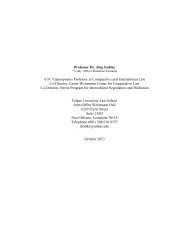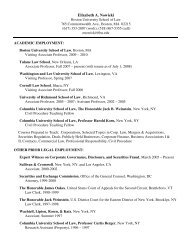Civil Codes of Louisiana - Tulane Law School - Tulane University
Civil Codes of Louisiana - Tulane Law School - Tulane University
Civil Codes of Louisiana - Tulane Law School - Tulane University
You also want an ePaper? Increase the reach of your titles
YUMPU automatically turns print PDFs into web optimized ePapers that Google loves.
Winter 2008 The <strong>Civil</strong> <strong>Codes</strong> <strong>of</strong> <strong>Louisiana</strong> 2<br />
entered the borders <strong>of</strong> the present state <strong>of</strong> <strong>Louisiana</strong> and was buried near the point<br />
where Red River empties into the Mississippi, but again there is lack <strong>of</strong><br />
conclusive pro<strong>of</strong>. Survivors <strong>of</strong> the de Soto expedition, however, did descend to<br />
the mouth <strong>of</strong> the Mississippi in 1543.<br />
2 Spain set up no claim to the region by right <strong>of</strong> discovery. Thus, Robert<br />
Cavelier, Sieur de la Salle, who came down the river in 1682 from the French<br />
possessions to the north, was able to take possession <strong>of</strong> the territory in the name<br />
<strong>of</strong> France. The new possession was given the name <strong>of</strong> <strong>Louisiana</strong>, in honor <strong>of</strong><br />
King Louis XIV. La Salle sought to establish a colony in 1684, but missed the<br />
mouth <strong>of</strong> the Mississippi and landed in Texas, where he was murdered a few years<br />
later by some <strong>of</strong> his followers. A second attempt to establish a colony was<br />
undertaken by D'Iberville, who reached the Gulf Coast in 1699 and established a<br />
fort about 40 miles above the mouth <strong>of</strong> the Mississippi. This was the earliest<br />
settlement within the boundaries <strong>of</strong> the present state <strong>of</strong> <strong>Louisiana</strong>.<br />
3 The legal history <strong>of</strong> <strong>Louisiana</strong> began in 1712 when Louis XIV granted a<br />
Charter to Antoine Crozat for the development, administration, and exploitation <strong>of</strong><br />
the possession. This Charter provided that the territory was to be governed by<br />
Edicts, Ordinances, and the Custom <strong>of</strong> Paris, namely a collection <strong>of</strong> customary<br />
rules prevailing in the city <strong>of</strong> Paris and its surrounding areas that had been<br />
reduced to writing in the sixteenth century. <strong>Louisiana</strong> proved a great burden on<br />
the purse <strong>of</strong> Crozat. In 1717, Crozat surrendered his Charter, and a new one was<br />
issued to John <strong>Law</strong>'s Company <strong>of</strong> the West, which provided for application <strong>of</strong> the<br />
same French laws. The Company <strong>of</strong> the West accomplished much for <strong>Louisiana</strong>.<br />
DeBienville, a brother <strong>of</strong> D'Iberville, was sent out as a governor, and established<br />
New Orleans in 1717. However, the company failed to realize pr<strong>of</strong>its, and<br />
eventually came to an end fatal to its creditors. It surrendered its Charter in 1731,<br />
and <strong>Louisiana</strong> became a crown colony, still governed by Edicts, Ordinances, and<br />
the Custom <strong>of</strong> Paris.<br />
B. Spanish Rule<br />
4 France ceded the <strong>Louisiana</strong> Territory to Spain in 1762 by the Treaty <strong>of</strong><br />
Fountainbleau. However, French laws continued to apply until November 25,<br />
1769, when a newly appointed Spanish Governor, Don Alexander O'Reilly, in his<br />
determination to wipe out remaining vestiges <strong>of</strong> French law, issued an Ordinance<br />
that was designed to organize an efficient government and administration <strong>of</strong><br />
justice in accordance with the Spanish laws. 2 Governor O'Reilly was a young<br />
Irishman who had risen to distinction in the Spanish Army. In the preamble, he<br />
stated the reasons for his legislation [sic]:<br />
2 See Schmidt, Ordinances and Instructions <strong>of</strong> Don Alexander O'Reilly, 1 LA. L. J. 1-60 (1841)<br />
(English translation by Schmidt). The Spanish original <strong>of</strong> the Ordinances is reprinted in B. TORRES<br />
RAMIREZ, ALEXANDRO O'REILLY EN LAS INDIAS 187-225 (1969).<br />
Vol. 1 CIVIL LAW COMMENTARIES Issue 1





